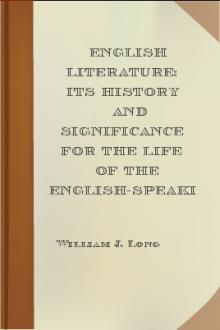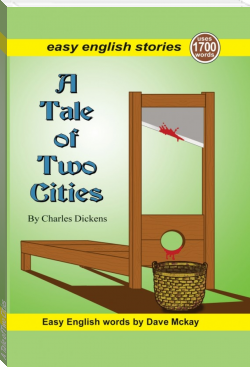English Literature: Its History and Significance for the Life of the English-Speaking World by William J. Long (good books for 8th graders txt) 📕

- Author: William J. Long
- Performer: -
Book online «English Literature: Its History and Significance for the Life of the English-Speaking World by William J. Long (good books for 8th graders txt) 📕». Author William J. Long
112. Malory has, in our own day, been identified with an English country gentleman and soldier, who was member of Parliament for Warwickshire in 1445.
113. For titles and publishers of general works see General Bibliography at the end of this book.
114. Eastward Ho! a play given in Blackfriars Theater about 1603. The play was written by Marston and two collaborators.
115. Lie so faint.
116. The View was not published till 1633.
117. clad.
118. handsome.
119. jousts, tournaments.
120. countenance.
121. dreaded.
122. took off.
123. pity.
124. know.
125. In the nineteenth century men learned again to appreciate Chaucer.
126. The most dramatic part of the early ritual centered about Christ's death and resurrection, on Good Fridays and Easter days. An exquisite account of this most impressive service is preserved in St. Ethelwold's Latin manual of church services, written about 965. The Latin and English versions are found in Chambers's Mediaeval Stage, Vol. II. For a brief, interesting description, see Gayley, Plays of Our Forefathers, pp. 14 ff.
127. How much we are indebted to the Norman love of pageantry for the development of the drama in England is an unanswered question. During the Middle Ages it was customary, in welcoming a monarch or in celebrating a royal wedding, to represent allegorical and mythological scenes, like the combat of St. George and the dragon, for instance, on a stage constructed for the purpose. These pageants were popular all over Europe and developed during the Renaissance into the dramatic form known as the Masque. Though the drama was of religious origin, we must not overlook these secular pageants as an important factor in the development of dramatic art.
128. Miracles were acted on the Continent earlier than this. The Normans undoubtedly brought religious plays with them, but it is probable that they began in England before the Conquest (1066). See Manly, Specimens of the Pre-Shaksperean Drama, I, xix.
129. See Jusserand, A Literary History of the English People, I, iii, vi. For our earliest plays and their authors see Gayley, Plays of Our Forefathers.
130. These three periods are not historically accurate. The author uses them to emphasize three different views of our earliest plays rather than to suggest that there was any orderly or chronological development from Miracle to Morality and thence to the Interludes. The latter is a prevalent opinion, but it seems hardly warranted by the facts. Thus, though the Miracles precede the Moralities by two centuries (the first known Morality, "The Play of the Lord's Prayer," mentioned by Wyclif, was given probably about 1375), some of the best known Moralities, like "Pride of Life," precede many of the later York Miracles. And the term Interlude, which is often used as symbolical of the transition from the moral to the artistic period of the drama, was occasionally used in England (fourteenth century) as synonymous with Miracle and again (sixteenth century) as synonymous with Comedy. That the drama had these three stages seems reasonably certain; but it is impossible to fix the limits of any one of them, and all three are sometimes seen together in one of the later Miracles of the Wakefield cycle.
131. In fact, Heywood "cribbed" from Chaucer's Tales in another Interlude called "The Pardoner and the Frere."
132. Schelling, Elizabethan Drama, I, 86.
133. That these gallants were an unmitigated nuisance, and had frequently to be silenced by the common people who came to enjoy the play, seems certain. Dekker's Gull's Hornbook (1609) has an interesting chapter on "How a Gallant should behave Himself in a Playhouse."
134. The first actors were classed with thieves and vagabonds; but they speedily raised their profession to an art and won a reputation which extended far abroad. Thus a contemporary, Fynes Moryson, writes in his Itinerary: "So I remember that when some of our cast despised stage players came ... into Germany and played at Franckford ... having nether a complete number of actors, nor any good aparell, nor any ornament of the stage, yet the Germans, not understanding a worde they sayde, both men and wemen, flocked wonderfully to see their gesture and action."
135. Schelling, Elizabethan Drama.
136. Baker, in his Development of Shakespeare as a Dramatist, pp. 57-62, takes a different view, and shows how carefully many of the boy actors were trained. It would require, however, a vigorous use of the imagination to be satisfied with a boy's presentation of Portia, Juliet, Cordelia, Rosalind, or any other of Shakespeare's wonderful women.
137. These choir masters had royal permits to take boys of good voice, wherever found, and train them as singers and actors. The boys were taken from their parents and were often half starved and most brutally treated. The abuse of this unnatural privilege led to the final withdrawal of all such permits.
138. So called from Euphues, the hero of Lyly's two prose works, Euphues, the Anatomy of Wit (1579), and Euphues and his England (1580). The style is affected and over-elegant, abounds in odd conceits, and uses hopelessly involved sentences. It is found in nearly all Elizabethan prose writers, and partially accounts for their general tendency to artificiality. Shakespeare satirizes euphuism in the character of Don Adriano of Love's Labour's Lost, but is himself tiresomely euphuistic at times, especially in his early or "Lylian" comedies. Lyly, by the way, did not invent the style, but did more than any other to diffuse it.
139. See Schelling, I, 211.
140. See p. 114.
141. In 1587 the first history of Johann Faust, a half-legendary German necromancer, appeared in Frankfort. Where Marlowe found the story is unknown; but he used it, as Goethe did two centuries later, for the basis of his great tragedy.
142. We must remember, however, that our present version of Faustus is very much mutilated, and does not preserve the play as Marlowe wrote it.
143. The two dramatists may have worked together in such doubtful plays as Richard III, the hero of which is like Timur in an English dress, and Titus Andronicus, with its violence and horror. In many strong scenes in Shakespeare's works Marlowe's influence is manifest.
144. Gammer Gurton's Needle appeared c. 1562; Love's Labour's Lost, c. 1591.
145. King John, IV, 2.
146. Queen Mab, in Romeo and Juliet.
147. By Archdeacon Davies, in the seventeenth century.
148. In 1709, nearly a century after the poet's death.
149. Robert Greene, one of the popular playwrights of the time, who attacked Shakespeare in a pamphlet called "A Groat's Worth of Wit Bought with a Million of Repentance." The pamphlet, aside from its jealousy of Shakespeare, is a sad picture of a man of genius dying of dissipation, and contains a warning to other playwrights of the time, whose lives were apparently almost as bad as that of Greene.
150. Love's Labour's Lost, Comedy of Errors, Two Gentlemen of Verona.
151. Henry VI, Richard III, Richard II, King John. Prior to 1588 only three true Chronicle plays are known to have been acted. The defeat of the Armada in that year led to an outburst of national feeling which found one outlet in the theaters, and in the next ten years over eighty Chronicle plays appeared. Of these Shakespeare furnished nine or ten. It was the great popular success of Henry VI, a revision of an old play, in 1592 that probably led to Greene's jealous attack.
152. See Lee's Life of William Shakespeare, pp. 188-196.
153. Like Henry VIII, and possibly the lost Cardenio.
154. A name given to the privilege--claimed by the mediæval Church for its clergy--of being exempt from trial by the regular law courts. After the Reformation the custom survived for a long time, and special privileges were allowed to ministers and their families. Jonson claimed the privilege as a minister's son.
155. A similar story of quackery is found in Chaucer, "The Canon's Yeoman's Tale."
156. In this and in A Fair Quarrel Middleton collaborated with William Rowley, of whom little is known except that he was an actor from c. 1607-1627.
157. The reader will find wholesome criticism of these writers, and selections from their works, in Charles Lamb's Specimens of English Dramatic Poets, an excellent book, which helps us to a better knowledge and appreciation of the lesser Elizabethan dramatists.
158. The first five books were published 1594-1597, and are as Hooker wrote them. The last three books, published after his death, are of doubtful authorship, but they are thought to have been completed from Hooker's notes.
159. For titles and publishers of reference works see General Bibliography at the end of this book.
160. See, for instance, the "Hymn to St. Theresa" and "The Flaming Heart."
161. So called from Pindar, the greatest lyric poet of Greece.
162. See, for instance, "Childhood," "The Retreat," "Corruption," "The Bird," "The Hidden Flower," for Vaughan's mystic interpretation of childhood and nature.
163. There is some doubt as to whether he was born at the Castle, or at Black Hall. Recent opinion inclines to the latter view.
164. "On his being arrived to the Age of Twenty-three."
165. "It is remarkable," says Lamartine, "how often in the libraries of Italian princes and in the correspondence of great Italian writers of this period you find mentioned the name and fame of this young Englishman."
166. In Milton's work we see plainly the progressive influence of the Puritan Age. Thus his Horton poems are joyous, almost Elizabethan in character; his prose is stern, militant, unyielding, like the Puritan in his struggle for liberty; his later poetry, following the apparent failure of Puritanism in the Restoration, has a note of sadness, yet proclaims the eternal principles of liberty and justice for which he had lived.
167. Of these sixty were taken from the Bible, thirty-three from English and five from Scotch history.
168. The latter was by Lewis Bayly, bishop of Bangor. It is interesting to note that this book, whose very title is unfamiliar to us, was speedily translated into five different languages. It had an enormous sale, and ran through fifty editions soon after publication.
169. Abridged from Grace Abounding, Part 3; Works (ed. 1873), p. 71.
170. For titles and publishers of reference works, see General Bibliography at the end of this book.
171. Guizot's History of the Revolution in England.
172. Jeremy Collier (1650-1726), a clergyman and author, noted for his scholarly Ecclesiastical History of Great Britain (1708-1714) and his Short View of the Immorality and Profaneness of the English Stage (1698). The latter was largely instrumental in correcting the low tendency of the Restoration drama.
173. The Royal Society, for the investigation and discussion of scientific questions, was founded in 1662, and soon included practically all of the literary and scientific men of the age. It encouraged the work





Comments (0)